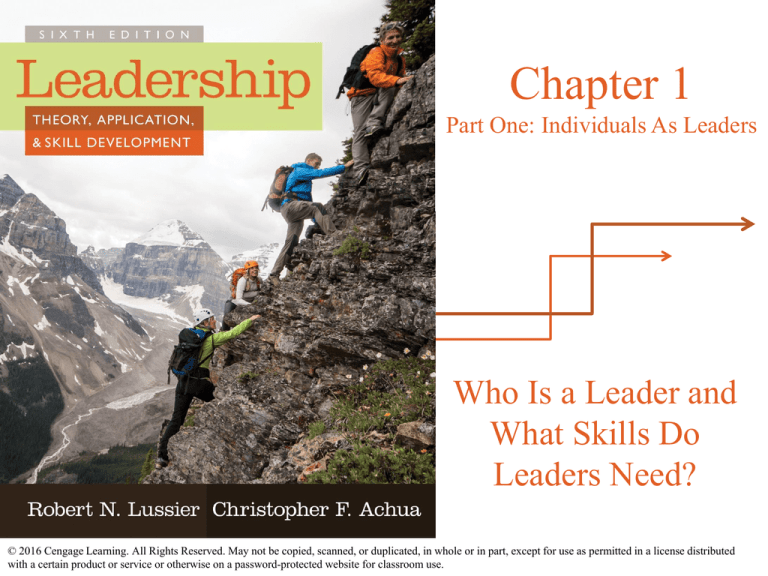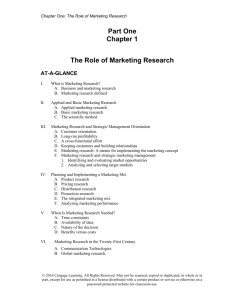
Chapter 1
Chapter
Part One:
Individuals As2Leaders
Who Is a Leader and
What Skills Do
Leaders Need?
© 2016 Cengage Learning. All Rights Reserved. May not be copied, scanned, or duplicated, in whole or in part, except for use as permitted in a license distributed
with a certain product or service or otherwise on a password-protected website for classroom use.
1-1
Learning Outcomes
1) Briefly describe the five key elements of leadership.
2) Identify and define the managerial leadership skills.
3) List the ten managerial roles based on their three
categories.
4) Explain the interrelationships among the levels of
leadership analysis.
5) Describe the major similarity and difference
between the trait and behavioral leadership
theories, and the interrelationships between them
and contingency theories.
© 2016 Cengage Learning. All Rights Reserved. May not be copied, scanned, or duplicated, in whole or in part, except for use as permitted in a license distributed
with a certain product or service or otherwise on a password-protected website for classroom use.
1-2
Leadership Described
• Leadership development.
> Leadership is everyone’s business.
• Why leadership development is important.
> Leadership is a key issue in management.
• Leadership applies to both your
professional and personal life.
• The first step to leadership development is
self-awareness of leadership competencies.
© 2016 Cengage Learning. All Rights Reserved. May not be copied, scanned, or duplicated, in whole or in part, except for use as permitted in a license distributed
with a certain product or service or otherwise on a password-protected website for classroom use.
1-3
Defining Leadership
Leadership is the influencing process of leaders
and followers to achieve organizational
objectives through change.
• Five key elements:
> Leaders-followers,
> Influence,
> Organizational objectives,
> People, and
> Change.
See Exhibit 1.1.
© 2016 Cengage Learning. All Rights Reserved. May not be copied, scanned, or duplicated, in whole or in part, except for use as permitted in a license distributed
with a certain product or service or otherwise on a password-protected website for classroom use.
1-4
Leadership – Five Key Elements
• Leaders-followers - leadership is shared.
• Influencing is the process of a leader
communicating ideas, gaining acceptance of them,
and motivating followers to support and implement
the ideas through change.
• Organizational objectives - effective leaders
•
•
influence followers to accomplish shared objectives.
Change - influencing and setting objectives is
about change.
People - leadership is about leading people
through relationships.
© 2016 Cengage Learning. All Rights Reserved. May not be copied, scanned, or duplicated, in whole or in part, except for use as permitted in a license distributed
with a certain product or service or otherwise on a password-protected website for classroom use.
1-5
Leadership Skills
• Are leaders born or made? Both
• Can leadership be taught & skills developed? Yes
• Managerial leadership skills:
> Technical Skills involve the ability to use methods and techniques
to perform a task;
> Interpersonal Skills involve the ability to understand, communicate
and work well with individuals and groups through developing
effective relationships; and
> Decision Making Skills are based on the ability to conceptualize
situations and select alternatives to solve problems and take
advantage of opportunities.
See Exhibit 1.2.
• The need for each skill varies based on management level.
© 2016 Cengage Learning. All Rights Reserved. May not be copied, scanned, or duplicated, in whole or in part, except for use as permitted in a license distributed
with a certain product or service or otherwise on a password-protected website for classroom use.
1-6
Leadership Managerial Roles
• Henry Mintzberg identified ten managerial
roles and grouped them into three categories.
> The managerial role categories are
interpersonal, informational, and decisional.
The interpersonal leadership roles include leader,
figurehead, and liaison.
o The informational leadership roles include monitor,
disseminator, and spokesperson.
o The decisional leadership roles include entrepreneur,
disturbance-handler, resource-allocator, and negotiator.
o
See Exhibit 1.3 .
© 2016 Cengage Learning. All Rights Reserved. May not be copied, scanned, or duplicated, in whole or in part, except for use as permitted in a license distributed
with a certain product or service or otherwise on a password-protected website for classroom use.
1-7
Levels of Analysis of Leadership
Theory
The three levels of analysis of leadership theory
are individual, group, and organizational.
> Individual level of analysis.
o
Also called the dyadic process – group and organizational
performance are based on individual performance.
> Group level of analysis.
o
Also called group process – productive groups means
productive individuals and organizations.
> Organizational level of analysis.
o
The organizational process focuses on the organization Working for a winning organization tends to motivate
individuals to perform at their best to stay on top.
See Exhibit 1.4.
© 2016 Cengage Learning. All Rights Reserved. May not be copied, scanned, or duplicated, in whole or in part, except for use as permitted in a license distributed
with a certain product or service or otherwise on a password-protected website for classroom use.
1-8
Leadership Theory Paradigms
• Leadership theory is an explanation of some
aspect of leadership; theories have practical
value because they are used to better
understand, predict, and control successful
leadership.
• Leadership theory classifications include
trait, behavioral, contingency, and integrative.
• Leadership paradigm is a shared mindset
that represents a fundamental way of thinking
about, perceiving, studying, researching, and
understanding leadership.
© 2016 Cengage Learning. All Rights Reserved. May not be copied, scanned, or duplicated, in whole or in part, except for use as permitted in a license distributed
with a certain product or service or otherwise on a password-protected website for classroom use.
1-9
Leadership Theory Paradigm
• Leadership trait theories
attempt to explain distinctive
characteristics accounting for leadership effectiveness.
• Behavioral leadership theories
attempt to explain
distinctive styles used by effective leaders, or to define the nature of
their work.
• Contingency leadership theories
attempt to explain the
appropriate leadership style based on the leader, followers, and
situation.
• Integrative leadership theories
attempt to combine the
trait, behavioral, and contingency theories to explain successful,
influencing leader-follower relationships.
• Management to leadership theory paradigm is a
shift from the older autocratic management style to the newer
participative leadership style of management.
© 2016 Cengage Learning. All Rights Reserved. May not be copied, scanned, or duplicated, in whole or in part, except for use as permitted in a license distributed
with a certain product or service or otherwise on a password-protected website for classroom use.
1 - 10
Book Objectives
• To teach you the theory and concepts of
leadership.
> Evidence-based management (EMB) means that
decisions and organizational practices are based on
the best available scientific evidence.
• To develop your ability to apply leadership
theory through critical thinking.
• To develop your leadership skills in your
personal and professional life.
See Exhibits 1.5 and 1.6.
© 2016 Cengage Learning. All Rights Reserved. May not be copied, scanned, or duplicated, in whole or in part, except for use as permitted in a license distributed
with a certain product or service or otherwise on a password-protected website for classroom use.
1 - 11
Key Terms
• behavioral leadership theories
• contingency leadership
theories
• decisional leadership roles
• decision-making skills
• evidence-based management
(EBM)
• influencing
• informational leadership roles
• integrative leadership theories
• interpersonal leadership roles
• interpersonal skills
•
•
•
•
•
•
•
•
•
leadership
leadership paradigm
leadership theory
leadership theory
classifications
leadership trait theories
levels of analysis of leadership
theory
management to the leadership
theory paradigm
managerial role categories
technical skills
© 2016 Cengage Learning. All Rights Reserved. May not be copied, scanned, or duplicated, in whole or in part, except for use as permitted in a license distributed
with a certain product or service or otherwise on a password-protected website for classroom use.
1 - 12












